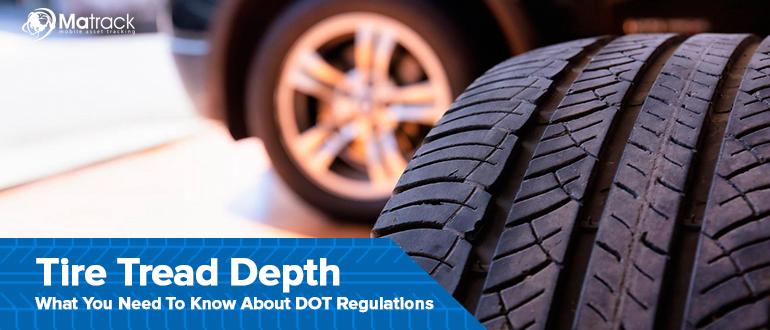Key Takeaway
- The tire tread depth is essential for keeping your vehicle safe. It helps your tires grip the road better and shorten the distance it takes to stop, especially when the roads are wet or slippery.
- The DOT rules say that passenger vehicles must have at least 2/32″ of tread depth, while commercial vehicles must have a minimum tread depth of 4/32″ on the front tires.
- Checking your tire tread regularly can help you avoid fines, follow safety rules, and lower the chance of getting into an accident.
- You can quickly check your tire tread using simple methods like the penny test or a tread depth gauge.
What is Tire Tread Depth?
Tire tread depth is how deep the grooves on a tire are from the surface to the bottom. It is usually measured in small units called 32nds of an inch and shows how well a tire can grip the road.
The proper tread depth is essential for keeping your vehicle safe and following the rules. It helps your vehicle handle better, stop faster, and stay stable in wet or slippery weather.
Why Is Tire Tread Depth Important?
Traction
Traction depends on having enough tread depth for the tires to grip the road effectively. This helps your car handle better, reduces the distance needed to stop, and keeps the vehicle steady, especially in rain, snow, or uneven conditions.
Hydroplaning Prevention
Hydroplaning is when tires lose contact with the road because of water. Tread depth helps channel water away, reducing the risk of slipping or losing control on wet surfaces.
Compliance
Compliance with tread depth rules ensures your tires are safe and meet legal standards. Following these regulations prevents fines, failed inspections, and unsafe driving conditions.
DOT Tread Depth Regulations
The DOT sets rules to ensure tire treads are deep enough to keep vehicles safe on public roads. These regulations help prevent accidents caused by worn-out tires and ensure vehicles meet safety standards.
Passenger Vehicles
Passenger vehicles must have a tread depth of at least 2/32″ in the main grooves of the tire. This is often checked with a tread depth gauge or by using the “penny test,” where part of the penny should remain covered by the tread.
Tires with less than 2/32″ of tread depth are considered unsafe and can lead to fines or other issues. Regularly checking tread depth is important for staying safe and following the law.
Commercial Vehicles
The tread depth requirements for commercial vehicles are stricter because of their size and weight. Steering axle tires must have a minimum tread depth of 4/32″ to ensure proper handling and stability.
All other tires on commercial vehicles must have at least 2/32″ of tread depth. Regular inspections are required, and tires should be replaced before they fall below these limits.
Motorcycles and Specialty Vehicles
Motorcycles and specialty vehicles must also maintain a minimum tread depth of 2/32″. This helps ensure good traction and safety in various driving conditions.
Although inspection rules may vary, keeping tires above the 2/32″ standard is critical for safe and legal operation.
What is the Legal Tire Tread Depth as per DOT Regulations?
The Department of Transportation (DOT) requires specific tread depths for tires to ensure safety on the road. The main requirements are:
- Steering Axle Tires: Front tires on buses, trucks, or truck tractors must have at least 4/32 of an inch of tread depth in the major grooves. This ensures proper grip and control, especially in wet or slippery conditions.
- Other Tires: All other tires on trucks and trailers must have a tread depth of at least 2/32 of an inch in the major grooves to maintain stability and traction.
Exceptions to the Regulations
Some vehicles have different rules or are exempt:
- Private Carriers: Vehicles used by businesses that don’t employ commercial drivers.
- Local Delivery Vehicles: Trucks over 10,000 pounds that operate only on local roads.
- Agricultural Vehicles: ATVs and vehicles used in farming, horticulture, or forestry work.
These exceptions apply to specific situations, but all vehicles should still be checked regularly to ensure tire safety.
Objectives of DOT Regulations on Tire Tread Depth
The DOT regulations ensure tires have enough tread depth to maintain safety and performance. Worn tires lose their grip on the road, increasing the risk of accidents and lowering fuel efficiency as the engine works harder.
By following these regulations and regularly checking tire tread, drivers can reduce accident risks, improve vehicle performance, and extend tire life. Proper maintenance also ensures fuel efficiency and compliance with safety standards.
How to measure tire tread depth?
You can check tire tread depth easily with tools or simple items:
- Tread Depth Gauge: A small tool that measures how deep the grooves are in 32nds of an inch.
- The Penny Test: Place a penny into the tread with Lincoln’s head pointing down. If you can see the top of his head, it’s time to replace the tire.
- Wear Indicators: Tires often have built-in wear bars that appear level with the tread when it reaches 2/32″, meaning the tire is too worn.
Checking tread depth regularly helps you spot problems early, keeping you safe and avoiding legal issues.
Consequences of Non-Compliance
Not following DOT tread depth rules can lead to fines or tickets during inspections or after an accident. These rules are there to make sure vehicles are safe to drive.
Worn tires make accidents more likely because they affect braking, steering, and stability, especially in bad weather. If your tires are unsafe, your insurance might not cover you, leaving you to pay for any damages.
Tire Tread Depth Maintenance Tips
Check Tread Depth Regularly
Check tread depth regularly using a tread depth gauge or the penny test. Doing this once a month helps you catch wear early and replace tires before they become unsafe.
Maintain Proper Tire Pressure
Maintain proper tire pressure to prevent uneven wear. Check your tire pressure often and keep it at the recommended level to ensure even tread wear and better gas mileage.
Rotate Tires Periodically
Rotate tires periodically every 5,000 to 7,500 miles or as recommended by your car’s manual. This helps all tires wear evenly and last longer.
Align and Balance Wheels
Align and balance wheels during routine servicing to avoid uneven wear. Proper alignment improves handling and keeps your tires in good shape.
Avoid Overloading Your Vehicle
Avoid overloading your vehicle to reduce stress on the tires. Too much weight can wear down the tread faster and decrease tire performance.
Inspect for Damage
Inspect for damage like cracks, bulges, or punctures every few weeks. Damaged tires wear out faster and can be dangerous to drive on.
Replace Tires When Necessary
Replace tires when necessary, especially if tread depth reaches 2/32″. Don’t wait until they are completely worn out, as it compromises safety.
Role of DOT in Maintaining Safety Standards
DOT regulations focus on keeping transportation safe. They set rules for drivers, vehicle maintenance, working hours, and drug and alcohol testing to reduce accidents and improve safety.
Driving Qualifications
Driving qualifications are outlined by DOT to make sure only skilled drivers are on the road. These include having the right licenses, medical checks, and proper training to lower the risk of accidents from unqualified drivers.
Vehicle Conditions
Vehicle conditions are regulated to keep cars, trucks, and buses in good shape. DOT requires regular inspections and maintenance to avoid breakdowns and technical issues that could cause accidents. Know more about DOT inspection.
Hours of Service (HOS)
Hours of Service rules limit how long drivers can be behind the wheel and require rest breaks. These rules help prevent fatigue, a major cause of road accidents, and keep drivers alert.
Testing for Drugs and Alcohol
Testing for drugs and alcohol ensures drivers are safe to operate vehicles. DOT rules require regular testing to identify and stop unsafe practices, promoting a safer environment for everyone.
Frequently Asked Questions
What is the minimum tread depth for front tires CDL?
The minimum tread depth for front tires on commercial vehicles (CDL) is 4/32 of an inch. This is measured in the major tread grooves and ensures proper handling and safety.
What is the tread depth of a new tire?
The tread depth of a new tire is typically between 10/32″ and 12/32″, depending on the type and purpose of the tire. For example, off-road or winter tires may have deeper treads than standard tires.
What is a good tire tread depth?
A good tire tread depth is anything above 4/32″ for most driving conditions. If the depth is below this, you should consider replacing the tires soon, especially for wet or snowy roads.
How to use a tire tread depth gauge?
To use a tire tread depth gauge, insert the probe into a tread groove and press the base flat against the tire surface. The reading on the gauge shows the depth of the tread in 32nds of an inch.
Tire tread depth: When to replace?
Replace your tires when the tread depth reaches 2/32″, as this is the legal minimum in most places. However, for better safety, consider replacing them if the tread depth is less than 4/32″, especially in wet or winter conditions.
Conclusion
Checking your tire tread depth is essential for vehicle safety and to comply with DOT regulations. Regular checks using a tread depth gauge or the penny test can help prevent accidents and ensure your vehicle runs smoothly.
Know your vehicle’s specific tread depth requirements. By following these guidelines, you can avoid fines, make your tires last longer, and improve fleet efficiency.






